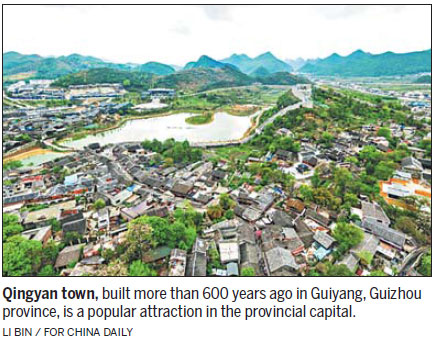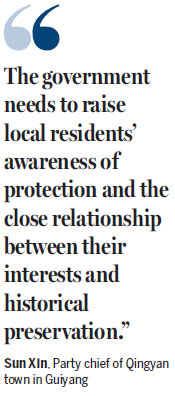

Qingyan town in Guiyang, Guizhou province, boasts more than 600 years of history. The ancient town, initially a garrison, was named after the green peaks nearby.
In 2013, the city government published a plan for the protective renovation of Qingyan, paying special attention to preserving the natural environment, historical buildings and local culture.
The core area of the ancient town will expand from 0.8 square kilometers to 4.8 square kilometers. Six new parking lots will be added, some ancient city walls will be rebuilt and a large number of public infrastructures will be improved, according to the plan.
Liu Guoping, a resident of the Mingqing residential community in Qingyan, said: "I have been busy since the plan was issued. I sometimes even have work to do on the weekend."
Liu, 68, was elected the community's Party chief several years ago, when he returned to Qingyan with his wife after retiring from another region where he worked.
"I planned to live a simple and leisurely life here, but the tourism development project of Qingyan changed all my post-retirement plans," Liu said. "The neighborhood trusts me. I must take my duty seriously."
Infrastructure improvements have laid a solid foundation for Qingyan to become a tourist destination.
Statistics from the government show that more than 10,000 people visit Qingyan every day on average, bringing about 60,000 yuan ($8,800) in per capita income to local residents. The provincial average personal income for farmers in Guizhou last year was barely 7,400 yuan.
Li Larong, an eatery owner in her 50s, is good at making local snacks in traditional ways.

"My family are all engaged in the business now," Li said. "We can earn more than 200,000 yuan a year."
After local residents get rich, they hope to build new homes or renovate their old homes with modern windows and other materials that would change the facade of the ancient buildings.
To persuade them to give up the plans and protect their old homes has become an important job for Liu.
"Local residents' awareness of historical building protection is still weak," Liu said. "I have quarreled with them on the issue."
Liu said he takes responsibility for the preservation of Qingyan.
"If the old things are destroyed, they cannot be restored, and Qingyan will be no different from any other town in China. It will have no future as a tourist destination of historical interest," he noted.
The community residential committee in Qingyan made a rule that all rebuilding and renovation of old houses must first be approved to minimize the changes in the houses' historical characteristics.
Sun Xin, Party chief of Qingyan, said: "The government needs to raise local residents' awareness of protection and the close relationship between their interests and historical preservation."
He added that the government intentionally put all hotels and large restaurants outside Qingyan in a bid to better preserve the ancient town.
The Guiyang government has attracted more than 6 billion yuan investment to develop Qingyan as a tourist destination.
According to its plan, Qingyan is expected to become a 5A-level tourist attraction, the highest level in China, over the next five years. It is designed to feature historical buildings, Zen culture and the Buyi ethnic culture.
Qingyan is one of the 100 tourist attractions in Guiyang that the city government started developing during the 12th Five-Year Plan period (2011-15).
The city government is now implementing an ambitious tourism action plan, which covers one river, more than 100 hills and some 1,000 parks.
Yuan Yunlong, head of the Guiyang tourism development commission, said that there are many natural scenic sites and places of interest along the Nanming River.
The 108 hills in urban areas are the focus of the city's environmental campaign, which will eventually be extended to the surrounding mountains.
Guiyang plans to build more than 1,000 forest parks, wetland parks, geology parks, city parks and community parks by 2020.
The city is well-known for its clean air, cool summer and well-preserved karst landscapes and plantation in China.
Guiyang will transform its tourism from merely focusing on scenic spots to developing the entire region as a comprehensive attraction, paying special attention to promoting related industries and improved public services, in a bid to make it a world-famous tourism destination, according to the city's development plan.
In the first three quarters of this year, Guiyang received 90.28 million traveler trips from home and abroad, up 33.3 percent year-on-year, and its revenue from tourism hit 112.55 billion yuan, up 35.6 percent year-on-year.
Li Yang contributed to this story.
(China Daily 12/21/2016 page7)